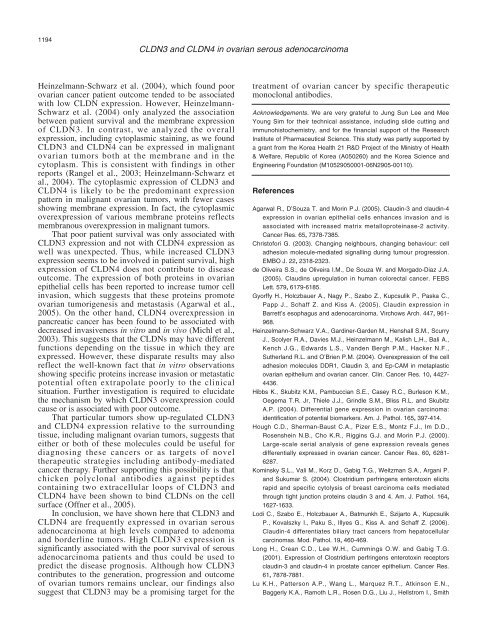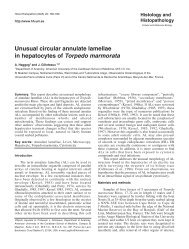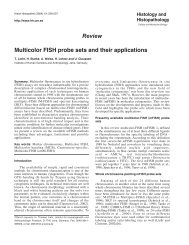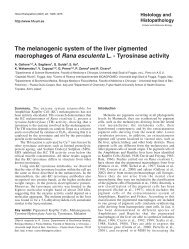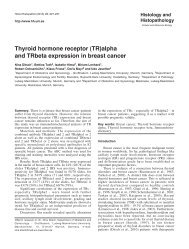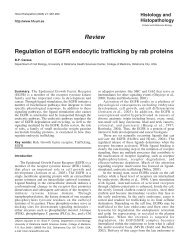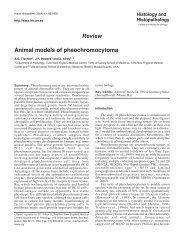Expression profile of tight junction protein claudin 3 and claudin 4 in ...
Expression profile of tight junction protein claudin 3 and claudin 4 in ...
Expression profile of tight junction protein claudin 3 and claudin 4 in ...
You also want an ePaper? Increase the reach of your titles
YUMPU automatically turns print PDFs into web optimized ePapers that Google loves.
1194<br />
CLDN3 <strong>and</strong> CLDN4 <strong>in</strong> ovarian serous adenocarc<strong>in</strong>oma<br />
He<strong>in</strong>zelmann-Schwarz et al. (2004), which found poor<br />
ovarian cancer patient outcome tended to be associated<br />
with low CLDN expression. However, He<strong>in</strong>zelmann-<br />
Schwarz et al. (2004) only analyzed the association<br />
between patient survival <strong>and</strong> the membrane expression<br />
<strong>of</strong> CLDN3. In contrast, we analyzed the overall<br />
expression, <strong>in</strong>clud<strong>in</strong>g cytoplasmic sta<strong>in</strong><strong>in</strong>g, as we found<br />
CLDN3 <strong>and</strong> CLDN4 can be expressed <strong>in</strong> malignant<br />
ovarian tumors both at the membrane <strong>and</strong> <strong>in</strong> the<br />
cytoplasm. This is consistent with f<strong>in</strong>d<strong>in</strong>gs <strong>in</strong> other<br />
reports (Rangel et al., 2003; He<strong>in</strong>zelmann-Schwarz et<br />
al., 2004). The cytoplasmic expression <strong>of</strong> CLDN3 <strong>and</strong><br />
CLDN4 is likely to be the predom<strong>in</strong>ant expression<br />
pattern <strong>in</strong> malignant ovarian tumors, with fewer cases<br />
show<strong>in</strong>g membrane expression. In fact, the cytoplasmic<br />
overexpression <strong>of</strong> various membrane <strong>prote<strong>in</strong></strong>s reflects<br />
membranous overexpression <strong>in</strong> malignant tumors.<br />
That poor patient survival was only associated with<br />
CLDN3 expression <strong>and</strong> not with CLDN4 expression as<br />
well was unexpected. Thus, while <strong>in</strong>creased CLDN3<br />
expression seems to be <strong>in</strong>volved <strong>in</strong> patient survival, high<br />
expression <strong>of</strong> CLDN4 does not contribute to disease<br />
outcome. The expression <strong>of</strong> both <strong>prote<strong>in</strong></strong>s <strong>in</strong> ovarian<br />
epithelial cells has been reported to <strong>in</strong>crease tumor cell<br />
<strong>in</strong>vasion, which suggests that these <strong>prote<strong>in</strong></strong>s promote<br />
ovarian tumorigenesis <strong>and</strong> metastasis (Agarwal et al.,<br />
2005). On the other h<strong>and</strong>, CLDN4 overexpression <strong>in</strong><br />
pancreatic cancer has been found to be associated with<br />
decreased <strong>in</strong>vasiveness <strong>in</strong> vitro <strong>and</strong> <strong>in</strong> vivo (Michl et al.,<br />
2003). This suggests that the CLDNs may have different<br />
functions depend<strong>in</strong>g on the tissue <strong>in</strong> which they are<br />
expressed. However, these disparate results may also<br />
reflect the well-known fact that <strong>in</strong> vitro observations<br />
show<strong>in</strong>g specific <strong>prote<strong>in</strong></strong>s <strong>in</strong>crease <strong>in</strong>vasion or metastatic<br />
potential <strong>of</strong>ten extrapolate poorly to the cl<strong>in</strong>ical<br />
situation. Further <strong>in</strong>vestigation is required to elucidate<br />
the mechanism by which CLDN3 overexpression could<br />
cause or is associated with poor outcome.<br />
That particular tumors show up-regulated CLDN3<br />
<strong>and</strong> CLDN4 expression relative to the surround<strong>in</strong>g<br />
tissue, <strong>in</strong>clud<strong>in</strong>g malignant ovarian tumors, suggests that<br />
either or both <strong>of</strong> these molecules could be useful for<br />
diagnos<strong>in</strong>g these cancers or as targets <strong>of</strong> novel<br />
therapeutic strategies <strong>in</strong>clud<strong>in</strong>g antibody-mediated<br />
cancer therapy. Further support<strong>in</strong>g this possibility is that<br />
chicken polyclonal antibodies aga<strong>in</strong>st peptides<br />
conta<strong>in</strong><strong>in</strong>g two extracellular loops <strong>of</strong> CLDN3 <strong>and</strong><br />
CLDN4 have been shown to b<strong>in</strong>d CLDNs on the cell<br />
surface (Offner et al., 2005).<br />
In conclusion, we have shown here that CLDN3 <strong>and</strong><br />
CLDN4 are frequently expressed <strong>in</strong> ovarian serous<br />
adenocarc<strong>in</strong>oma at high levels compared to adenoma<br />
<strong>and</strong> borderl<strong>in</strong>e tumors. High CLDN3 expression is<br />
significantly associated with the poor survival <strong>of</strong> serous<br />
adenocarc<strong>in</strong>oma patients <strong>and</strong> thus could be used to<br />
predict the disease prognosis. Although how CLDN3<br />
contributes to the generation, progression <strong>and</strong> outcome<br />
<strong>of</strong> ovarian tumors rema<strong>in</strong>s unclear, our f<strong>in</strong>d<strong>in</strong>gs also<br />
suggest that CLDN3 may be a promis<strong>in</strong>g target for the<br />
treatment <strong>of</strong> ovarian cancer by specific therapeutic<br />
monoclonal antibodies.<br />
Acknowledgements. We are very grateful to Jung Sun Lee <strong>and</strong> Mee<br />
Young Sim for their technical assistance, <strong>in</strong>clud<strong>in</strong>g slide cutt<strong>in</strong>g <strong>and</strong><br />
immunohistochemistry, <strong>and</strong> for the f<strong>in</strong>ancial support <strong>of</strong> the Research<br />
Institute <strong>of</strong> Pharmaceutical Science. This study was partly supported by<br />
a grant from the Korea Health 21 R&D Project <strong>of</strong> the M<strong>in</strong>istry <strong>of</strong> Health<br />
& Welfare, Republic <strong>of</strong> Korea (A050260) <strong>and</strong> the Korea Science <strong>and</strong><br />
Eng<strong>in</strong>eer<strong>in</strong>g Foundation (M10529050001-06N2905-00110).<br />
References<br />
Agarwal R., D’Souza T. <strong>and</strong> Mor<strong>in</strong> P.J. (2005). Claud<strong>in</strong>-3 <strong>and</strong> <strong>claud<strong>in</strong></strong>-4<br />
expression <strong>in</strong> ovarian epithelial cells enhances <strong>in</strong>vasion <strong>and</strong> is<br />
associated with <strong>in</strong>creased matrix metallo<strong>prote<strong>in</strong></strong>ase-2 activity.<br />
Cancer Res. 65, 7378-7385.<br />
Christ<strong>of</strong>ori G. (2003). Chang<strong>in</strong>g neighbours, chang<strong>in</strong>g behaviour: cell<br />
adhesion molecule-mediated signall<strong>in</strong>g dur<strong>in</strong>g tumour progression.<br />
EMBO J. 22, 2318-2323.<br />
de Oliveira S.S., de Oliveira I.M., De Souza W. <strong>and</strong> Morgado-Diaz J.A.<br />
(2005). Claud<strong>in</strong>s upregulation <strong>in</strong> human colorectal cancer. FEBS<br />
Lett. 579, 6179-6185.<br />
Gyorffy H., Holczbauer A., Nagy P., Szabo Z., Kupcsulik P., Paska C.,<br />
Papp J., Schaff Z. <strong>and</strong> Kiss A. (2005). Claud<strong>in</strong> expression <strong>in</strong><br />
Barrett’s esophagus <strong>and</strong> adenocarc<strong>in</strong>oma. Virchows Arch. 447, 961-<br />
968.<br />
He<strong>in</strong>zelmann-Schwarz V.A., Gard<strong>in</strong>er-Garden M., Henshall S.M., Scurry<br />
J., Scolyer R.A., Davies M.J., He<strong>in</strong>zelmann M., Kalish L.H., Bali A.,<br />
Kench J.G., Edwards L.S., V<strong>and</strong>en Bergh P.M., Hacker N.F.,<br />
Sutherl<strong>and</strong> R.L. <strong>and</strong> O’Brien P.M. (2004). Overexpression <strong>of</strong> the cell<br />
adhesion molecules DDR1, Claud<strong>in</strong> 3, <strong>and</strong> Ep-CAM <strong>in</strong> metaplastic<br />
ovarian epithelium <strong>and</strong> ovarian cancer. Cl<strong>in</strong>. Cancer Res. 10, 4427-<br />
4436.<br />
Hibbs K., Skubitz K.M., Pambuccian S.E., Casey R.C., Burleson K.M.,<br />
Oegema T.R. Jr, Thiele J.J., Gr<strong>in</strong>dle S.M., Bliss R.L. <strong>and</strong> Skubitz<br />
A.P. (2004). Differential gene expression <strong>in</strong> ovarian carc<strong>in</strong>oma:<br />
identification <strong>of</strong> potential biomarkers. Am. J. Pathol. 165, 397-414.<br />
Hough C.D., Sherman-Baust C.A., Pizer E.S., Montz F.J., Im D.D.,<br />
Rosenshe<strong>in</strong> N.B., Cho K.R., Rigg<strong>in</strong>s G.J. <strong>and</strong> Mor<strong>in</strong> P.J. (2000).<br />
Large-scale serial analysis <strong>of</strong> gene expression reveals genes<br />
differentially expressed <strong>in</strong> ovarian cancer. Cancer Res. 60, 6281-<br />
6287.<br />
Kom<strong>in</strong>sky S.L., Vali M., Korz D., Gabig T.G., Weitzman S.A., Argani P.<br />
<strong>and</strong> Sukumar S. (2004). Clostridium perfr<strong>in</strong>gens enterotox<strong>in</strong> elicits<br />
rapid <strong>and</strong> specific cytolysis <strong>of</strong> breast carc<strong>in</strong>oma cells mediated<br />
through <strong>tight</strong> <strong>junction</strong> <strong>prote<strong>in</strong></strong>s <strong>claud<strong>in</strong></strong> 3 <strong>and</strong> 4. Am. J. Pathol. 164,<br />
1627-1633.<br />
Lodi C., Szabo E., Holczbauer A., Batmunkh E., Szijarto A., Kupcsulik<br />
P., Kovalszky I., Paku S., Illyes G., Kiss A. <strong>and</strong> Schaff Z. (2006).<br />
Claud<strong>in</strong>-4 differentiates biliary tract cancers from hepatocellular<br />
carc<strong>in</strong>omas. Mod. Pathol. 19, 460-469.<br />
Long H., Crean C.D., Lee W.H., Cumm<strong>in</strong>gs O.W. <strong>and</strong> Gabig T.G.<br />
(2001). <strong>Expression</strong> <strong>of</strong> Clostridium perfr<strong>in</strong>gens enterotox<strong>in</strong> receptors<br />
<strong>claud<strong>in</strong></strong>-3 <strong>and</strong> <strong>claud<strong>in</strong></strong>-4 <strong>in</strong> prostate cancer epithelium. Cancer Res.<br />
61, 7878-7881.<br />
Lu K.H., Patterson A.P., Wang L., Marquez R.T., Atk<strong>in</strong>son E.N.,<br />
Baggerly K.A., Ramoth L.R., Rosen D.G., Liu J., Hellstrom I., Smith


